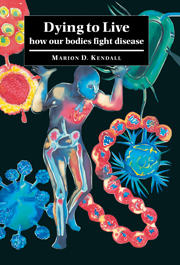9 - Struggle for Survival
Published online by Cambridge University Press: 29 September 2009
Summary
Breast cancer This is the second most common cancer of women in the world, causing some 500,000 deaths each year. In North America, it carries a 12.5% ‘risk rate’, which means that about one in eight women will develop breast cancer, and each year some 46,000 will die from it. For the United Kingdom the rate is 1 in 12, or an 8% risk, with a similar proportion of women who die. Although detection rates have improved, and therefore the incidence appears to be rising, the death rates have remained stable. There are many factors that increase the risk of getting breast cancer, ranging from a woman's age, where she was born, her standard of socio-economic grouping, whether she is overweight, to family histories of breast and ovarian cancers. The fact that it often occurs around the age of 50, and is less common in younger women, may be related to the levels of the female sex hormones, particularly oestrogen, as they are growth stimulators. As breast cancer progresses so the cancer cells stop responding to oestrogens and become ‘fixed’ in a proliferating mode. The levels of these hormones wax and wane throughout life, especially through the menstrual cycle, pregnancy and the menopause, as well as with the degree of obesity. Women who have had their ovaries removed before the age of 35 years rarely get breast cancer.
- Type
- Chapter
- Information
- Dying to LiveHow our Bodies Fight Disease, pp. 146 - 164Publisher: Cambridge University PressPrint publication year: 1998



